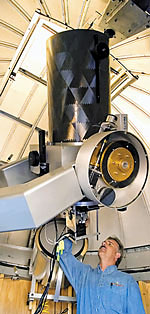|
Asteroids bear school, educator's monikers
By Elizabeth Hardin-Burrola
Staff Writer

Mike De Young inspects the Calvin College Telescope at the Rehoboth
Observatory on Thursday afternoon. De Young has been teaching
and working for Rehoboth for the past 30 years, and one of his
duties is managing the Rehoboth Observatory. [Photo by Matt
Hinshaw/Independent] |
REHOBOTH — Thanks to the discovery of a two asteroids
orbiting the sun, the Rehoboth Christian School community is now
officially linked to the international astronomy community.
Just a few years ago, those asteroids — rocky objects that
are sometimes called "minor planets" or "space junk"
depending on terminology — had yet to be discovered.
Then on Oct. 12, 2005, one asteroid was discovered through the use
of a remote-controlled telescope located in an observatory south
of the Rehoboth campus. It was given the provisional and unexciting
scientific name of Asteroid 145475. On Jan. 6, 2006, a second asteroid
was discovered through the same Rehoboth telescope and given the
provisional name of Asteroid 134244.
Recently, however, the Asteroid 145475 was officially named "Rehoboth"
to honor Rehoboth Christian School for providing an observatory
site for the remote-controlled telescope, and the second asteroid
was officially named "De Young" in honor of Mike De Young,
the Rehoboth educator who works as the local liaison for the observatory.
In a recent interview, De Young admitted he was "surprised
and honored" to learn that the newly discovered asteroids would
bear the name of the school he has worked at for 30 years and his
own surname.
"It's just kind of a neat honor," said De Young, Rehoboth's
network administrator, who currently oversees the school's technology
system. A former longtime science teacher, De Young periodically
hosts public star parties at the observatory.
Although located on Rehoboth land, the observatory is actually owned
and operated by Calvin College in Michigan. Using grant money from
the National Science Foundation, Calvin installed a new, computer-controlled
telescope in Michigan and built the Rehoboth observatory in 2004
and installed a second computer-controlled telescope here. Under
the direction of Professor Larry Molnar and Calvin's Physics and
Astronomy Department, science students in Michigan operate the Rehoboth
telescope via the Internet.
De Young assisted in the project by helping with the site development,
he said, and working with local contractors during the observatory's
construction. He continues to help through maintenance of the telescope
and observatory.
Molnar and Calvin chose the Rehoboth site, said De Young, because
of the local area's clear skies, high elevation, and low light pollution.
"This particular facility seems to be ideal for it," he
said.
According to De Young, the newly named asteroids are just two of
about 120 asteroids that may have been discovered through the use
of the Rehoboth remote-controlled telescope. About 23 of the asteroids
have confirmed orbital paths, he explained, and the rest are still
being investigated.
According to a Calvin news release, a newly discovered asteroid
is given a provisional name but must be tracked for a length of
time to fully document its orbit. The object is registered with
the Minor Planet Center of the Harvard-Smithsonian Center for Astrophysics
and is assigned a number indicating its order of discovery. Once
the asteroid's orbit is fully documented, the discoverer of the
asteroid is invited to suggest a name to the International Astronomical
Union's Committee on Small Body Nomenclature.
As the discoverer of the two asteroids, Professor Molnar chose the
names "Rehoboth" and "De Young." Two previously
discovered asteroids were named after a former Calvin College president
and professor.
Although asteroids can be several hundred miles in diameter, "Rehoboth"
and "De Young" are less than 2 1/2 miles in diameter.
"De Young" takes about 4.50 years to orbit the sun.
"The recent discoveries and names are part of a growing Calvin
astronomy program that sees Calvin classes making regular new finds
in the heavens," the Calvin press release said.
"Classroom observations of asteroids have been a featured use
since the commissioning of the new telescopes," said Molnar
in the Calvin news release. "Our goal is for students to understand
better how real science works by aiming for a new discovery. As
far as we know, this is the only astronomy class in the world in
which discovery of a new solar system object is a regular assignment."
De Young, who earned his bachelor's degree at Calvin in 1976, agreed.
In addition to locating asteroids, he said, the Calvin-Rehoboth
Robotic Observatory has been used by Calvin students to monitor
variable stars, which are stars that tend to brighten and then dim.
Much of this astronomy research, he added, is being done by undergraduate
students, whereas at other colleges, such research would be limited
to graduate students.
For more information about Calvin College's astronomy discoveries,
visit www.calvin.edu/academic/phy/observatory. For more information
about the next Rehoboth Star Party, contact Mike De Young at (505)
726-9630.
|
Monday
April 23, 2007
Selected
Stories:
Official:
Old coal mine no problem; Construction will go on at Chuska Apts.
Leader:
Protect Hopi tradition; Religious leader warns of consequences in
Nuvamsa case
Dog
park unleashes its appeal at dedication
Asteroids
bear school, educator's monikers
Deaths
|



